Culture Watch

NATALIE BERGMAN DID NOT anticipate a particular response from Christians to her first solo album, Mercy. Released in May 2021, it was a departure from Bergman’s work with her brother in the duo Wild Belle, offering a gentler sound and deep lyrics. Yet Mercy has been hailed as a masterpiece that explores gospel through the lens of grief. Christians, particularly millennials and Gen Zers who long ago grew sick of Air1 and K-LOVE, have celebrated the work.
But Bergman wasn’t thinking about listener reaction before releasing Mercy. She wrote, produced, and mixed the album entirely by herself to process the grief after her father and stepmother were killed by a drunk driver. She said she felt “protected” in its release.
“I knew—after I put the album out—that I was going to have some sort of feedback on [Mercy] from people that are believers ... but I went into this with no fear,” Bergman told Sojourners before her March performance at Songbyrd Music House in Washington, D.C. Citing right-wing trucker protests and other authoritarian manifestations of Christianity, Bergman said she realized later it was a “kind of courageous thing to [release] this body of work, because of the political climate and because of the history that religion has.”
Mercy and the follow-up EP, Keep Those Teardrops from Falling, are fundamentally gospel in every sense of the term.
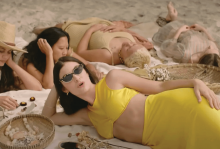
“DO NOT LOOK AWAY. Do not avert your gaze. Do not turn aside.” These words met me a few weeks ago via ecologist Joanna Macy’s ever-relevant book World as Lover, World as Self. I love these words, even though their charge is not an easy one. Looking at what is, without turning away, without aversion, takes incredible strength of will, especially in a culture that banks on our inability to pay attention or handle despair. Nonetheless, for Macy, the illumination of sustainable futures is impossible without first facing our grief. Which brings me, in an extremely roundabout way, to Jane Campion’s film The Power of the Dog and Lorde’s 2021 album Solar Power.

ALINE MELLO WAS 7 years old when she left Brazil with her parents and sister for what was supposed to be a short-term stay in the United States. Growing up undocumented, Mello turned to writing to process her questions about belonging and relationships. More Salt than Diamond (Andrews McMeel Publishing), her debut poetry collection, pulses with themes of identity, religion, and living as an immigrant in tumultuous times. Sojourners columnist Liuan Huska spoke with Mello, a graduate fellow in creative writing at Ohio State University, about race, language, and coming back around to God after disillusionment with the church.
Liuan Huska: What were the circumstances of your family’s emigration from Brazil?
Aline Mello: We emigrated in 1997. We were pretty poor. We had a lot of faith that if we were going to the U.S., it was because God wanted us to go. My uncle got a tourist visa for the four of us to go to Somerville, Mass. It was just going to be three years.
My father had this thing where he would follow charismatic pastors, and we followed one to Atlanta in 2000, right before 9/11. I had been told [incorrectly], “If you stay here for 10 years, you automatically get papers.” I thought, “Okay, I’m going to be fine.”
Right when I graduated high school, in 2007, my father left us. My mom literally got home from work one day and got a voice mail from him saying, “Hey, I left the country.” I realized I couldn’t go to college in Brazil because I didn’t know college-level Portuguese. And I had scholarships here. The goal was to go to college and then go back. Then DACA [Deferred Action for Childhood Arrivals] happened. So I thought, “Obviously, God wants me to stay.” You keep getting scraps enough [that] you don’t starve.
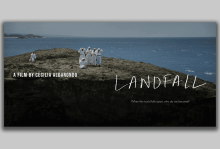
Creative Action
Capturing the vibrant 2019 protests that pushed Puerto Rico’s governor to resign, the documentary Landfall examines life after Hurricane María and the debt and environmental crises that devastated the U.S. colony long before, prompting local resistance and creative action. Blackscrackle Films.
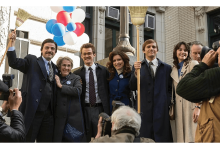
WHEN I THINK about the 2015 HBO miniseries Show Me a Hero, the person who first comes to mind is Nick Wasicsko. This is understandable: According to its HBO blurb, the politician is the show’s main protagonist. But this scripted drama is about the real-life 1980s and ’90s struggle for public housing in Yonkers, N.Y., when low-income people of color worked for integration and the city government resisted—even as daily contempt-of-court fines threatened to bankrupt it. So, it feels weird to focus on the white Mayor Wasicsko, although he (eventually) fights for the public housing too.
This discomfort may be the point. “The thing I don’t buy anymore,” said the show’s co-writer, David Simon (The Wire, Treme), “is if we elect the right guy, the great men of history, that’ll save us. ... Our problems are systemic, and we’re going to have to solve them as people.”
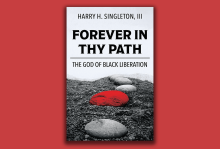
Used with permission from Orbis Books (orbisbooks.com)
TO ITS CREDIT, the Black church seeks to instill a sense of “somebodyness” through positive reinforcement in conversion. But it seeks to do so without deeply immersing the convert in the true history of his/her culture. Consequently, the Black church falls prey to the universalism of the white church by naïvely thinking that one can be a true child of God while possessed of a deformed racial self-image. In so doing, the static conservatism of the Black church is at odds with freedom movements and prophetic leaders who are able to judge rightly that the freedom of Blacks cannot come through a rejection of one’s history, whether intentional or not.
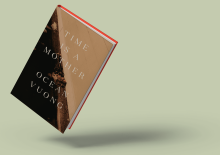
IN OCEAN VUONG'S latest collection Time Is a Mother, the T.S. Eliot Prize-winning poet reaches for depths of what was lost.
We encounter Vuong submerged in profound and compounding grief after the death of his mother. The book’s epigraph from César Vallejo reads, “Forgive me, Lord: I’ve died so little,” touching on the guilt that can accompany those left behind after a death. These poems hold the tension between looking back and moving forward, with the awareness of someone acquainted with feelings “that made death so large it was indistinguishable / from air,” as Vuong writes in “Not Even.” Those grieving search for comfort, while also examining life before loss—sometimes recognizing that grief was always present.
Time Is a Mother is full of questions that reckon with these past experiences. One of the first poems asks, “How else do we return to ourselves but to fold / The page so it points to the good part.” Other verses ask, “What if it wasn’t the crash that made us, but the debris?” and “How come the past tense is always longer?”

WHEN I PICKED up Get Untamed—a journal based on Glennon Doyle’s best-selling memoir Untamed—at a secondhand bookstore, I was, as the kids say, down bad. Real bad. A year of overscheduling, overcommitting, and underhydrating had turned me into the caretaker of a creative and existential abyss. In that bookstore, I was reaching for more than a how-to book. I was reaching for a lifeline. And I found one—just not in the way I expected.
Doyle emerged onto the nonfiction scene with Carry On, Warrior in 2013, followed by Love Warrior in 2016. The latter book was raw and vulnerable, detailing the dissolution and resurrection of Doyle’s first marriage. Acclaimed by Oprah, Brené Brown, and Elizabeth Gilbert, Love Warrior celebrated love’s ability to overcome all obstacles—from addiction to internalized misogyny—in a marriage. Then Doyle met retired professional soccer player Abby Wambach. Doyle and her husband divorced. Now Doyle and Wambach are, by all accounts, happily married. The events leading to this form the basis for Untamed.

WHEN I FIRST read Gwendolyn Brooks’ poem “truth” early last year, I did a double take to make sure it wasn’t written in 2021. The 1987 poem personifies its titular subject as a living being that can knock its “firm knuckles / Hard on the door,” whose arrival brings an equal mix of anticipation and apprehension. Brooks describes multiple responses one can have to the arrival of truth. For those who have made peace with lies, the truth can be threatening: “Shall we not dread him, / Shall we not fear him / After so lengthy a / Session with shade?” Even for those who have longed for truth’s arrival, blissful or willful ignorance seems to be a better alternative than the terror of having to engage truth head on: “Shall we not shudder?— / Shall we not flee / Into the shelter, the dear thick shelter / Of the familiar / Propitious haze?” Regardless, Brooks makes one thing clear: The question is not a matter of if truth will come, but when. The most important question of our lives then becomes, how are we to greet it?
In the poem, Brooks doesn’t name the truth that haunts her—although since she first published it in 1949, as the stage for the civil rights movement was being set, one possibility might be the systemic mistreatment of Black people and white people’s willful obliviousness to it. I found the poem to be a peculiar comfort in this time as we try to adjust to an ever-shifting landscape of new realities and reckon with truths about ourselves we might otherwise prefer remain hidden.
Similarly, several films offer insight into how people receive truth’s advent.

THE POWER OF the TV drama Tehran, about an Israeli spy who was born in Iran to a Jewish family and returns to her birthplace to help destroy a nuclear reactor, lies partly in how it parallels reality. On the other side of the screen, President Joe Biden continues to face the fallout of President Donald Trump’s decisions to withdraw the United States from the Iran nuclear deal and recognize Jerusalem as the capital of Israel, while tensions between Iran and Israel simmer.
But relevance alone doesn’t win an International Emmy Award for Best Drama. With her lifelong ties to both Israel and Iran, Tehran’s hacker-agent Tamar Rabinyan is a unique protagonist, and Tehran perfectly executes the thrills and twists that draw people to the spy genre. The show also is violent—guns, blood, an attempted rape that ends with the killing of the attacker, and a shot of a man hanged from a crane, presumably executed by the government. The more I watched, the more I felt a pang in my chest, wondering whether Rabinyan would survive.
Tehran is not all stress, though—at least not for the viewer. Rabinyan’s family members become entangled with the show’s plot in a pleasurably Shakespearean fashion, mirroring each other and possessing information their kin may not know but the viewer does. A romance grows between Rabinyan and an Iranian hacker named Milad. When the show pauses the action to linger on characters and personal relationships, we can reflect on the humanity of Muslim and Jewish lives. Even clichéd techniques provide this opportunity, such as a scene in slo-mo—which I would have foregone for regular-speed footage—of Iranian university students protesting restrictions imposed by their government as other students counterprotest in support of the government’s conservative stance.
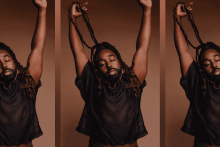
A MYKAL KILGORE performance isn’t just a show or concert; it’s an experience. Kilgore’s mind-blowing vocals and presence captivate, yes, but there’s more to it than that. In creating an atmosphere abundant in inclusion, empowerment, freedom, joy, truth, and love, Kilgore ministers to the soul. It’s a taste of the beloved community we hunger for.
A Black queer man, Kilgore uses his platform and prodigious talent to advocate for Black and LGBTQ issues. With a Grammy nomination in 2020 for his performance of the song “Let Me Go” further raising his profile, he’s getting even more opportunities to educate and entertain. In December, Kilgore spoke with writer and filmmaker Rebecca Riley via Zoom.
Rebecca Riley: When you perform, what do you hope audiences experience and take with them?
Mykal Kilgore: I want us to do a better job of being present with one another and seeing the thing inside each other that is eternal and sacred and perfect and special: I think that it is God. I want people to leave feeling like they have had a human experience at the show that allows them, and forces them, to be in their own emotions, to find pockets of empathy for others, and, more than anything else, to just truly see one another.
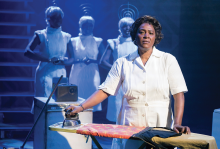
“NOTHING EVER HAPPEN under ground in Louisiana / Cause they ain’t no under ground in Louisiana. / There is only / under water.” With these words, playwright Tony Kushner draws us into the conundrum at the heart of the musical Caroline, or Change: How do you swim when you’re already so far below sea level? Caroline Thibodeaux (played by Sharon D Clarke in Roundabout Theatre Company’s Broadway revival production) is our eponymous anti-heroine, a 39-year-old maid and divorced mother of four, trying desperately to answer this question in every area of her life.
Based in part on Kushner’s own childhood, Caroline, or Change speaks through the sounds of Motown, gospel, klezmer, and blues—handily packaged by composer Jeanine Tesori—to tell the story of an uneasy friendship between Caroline and her employer’s son, 8-year-old Noah Gellman. The Gellman home becomes a larger metaphor for a country stratified by a brutal socioeconomic caste system, emphasized in the staging by a multilevel set. The structure of 1960s America is made visible, placing each character in predetermined roles, and thus unable to truly see each other.

SOME TV SHOWS are as great as our greatest literature. Programs such as The Sopranos, The Wire, Mad Men, and Breaking Bad are Dickensian in their sprawl and Shakespearean in their tragic characters’ deceptions. But one show in this current Golden Age of television is the most oft-overlooked of its peers, one whose greater feat—or unfairness to screenwriters—is that it’s not scripted. I’m talking about A&E’s reality show Hoarders.
I’m not kidding. What often draws people to watch those suffering from hoarding disorder and the psychologists, professional organizers, and loved ones trying to help them overcome mental illness is the typical reality TV magnet: Seeing the life of someone worse off than you. But there’s more to Hoarders than that. A good episode is nothing less than a short story similar to those by Alice Munro, vivid in its deep analysis of real life, family dynamics, and psyches in danger and repair. Almost every night for the past month, watching has been like studying fiction writing in some of the best (and cheapest) creative writing courses I’ve ever taken.

HISTORY HAS PAID personal attention to Lawrence Joseph, a Maronite Catholic from Detroit. In 1967, when Joseph was 19 and just finished with his freshman year at the University of Michigan, his father’s grocery-liquor store was looted and burned during the Detroit Rebellion. The five-day uprising of Black people reacting in part to police abuse and brutality and its fierce suppression by law enforcement and the National Guard made him “acutely conscious of America’s deeply systemic violence.”
Joseph, a poet who was also a lawyer who taught at St. John’s University in Queens, N.Y., and at Princeton, was living a block from the World Trade Center in 2001 when the two planes attacked. He and his wife had to evacuate their apartment. It was weeks before they could return. In the title poem of his 2017 volume So Where Are We?, Joseph writes:
flailing bodies in midair—
the neighborhood under thick gray powder—
on every screen. I don’t know
where you are, I don’t know what
I’m going to do, I heard a man say;
the man who had spoken was myself.

THE MET GALA is fascinating. Part chaos and part fundraiser, the Gala has created a treasure trove of cultural touchstones and meme-worthy content over the past few years. Created in the 1940s to benefit the Metropolitan Museum of Art’s Costume Institute, the Gala is, at its core, a paean to the sartorial arts. In many ways, it’s the gift that keeps on giving, especially if you, like me, are not opposed to a lot of pomp and very little circumstance. However, in the thick of my 2 a.m. behind-the-scenes-at-the-Met video binge, a thought occurred to me that I’ve been turning over ever since: America may not have bread, but it sure has circuses.

AS NEW YORK CITY'S elected public advocate since 2019, Brooklyn native Jumaane Williams is the ombudsman for more than 8 million people in all five boroughs, charged with overseeing city agencies and investigating citizen complaints. And, starting in 2016, when he was a member of the New York City Council, he has performed in more than 40 staged readings of plays, most of them classical tragedies, with Theater of War Productions.
Starting in 2009 with a performance of scenes from “Ajax” and “Philoctetes” by Sophocles that highlighted the issue of military PTSD, Theater of War Productions has presented dramatic readings of classical Greek tragedies and other plays followed by guided discussions linking their themes to contemporary social issues. It now has a repertory of more than 20 works addressing a wide range of complex social issues—from racism to refugees, gun violence to sexual assault, frontline medical worker mental health to criminal justice, and more. Essential to the experience are post-performance discussions in which audiences engage with the play’s themes, creating cathartic release and deepening understanding. During the pandemic, Theater of War has gone online, reaching a vast international audience.

I WOULDN'T WISH on anyone the narrative dilemma facing the writers of United States of Al. The CBS show is a buddy comedy about a young Afghan man who finally gets a visa to come to the U.S., thanks to a Marine, Riley, for whom he was an interpreter during the Afghanistan War, whose life he saved, and with whom he’s living in the States. But United States of Al’s second season, with an Oct. 7 premiere, may need to encompass even more grief than its predecessor. The U.S. has withdrawn from Afghanistan, and the Taliban has taken over. We’ve seen the video of Afghan people trying to hold on to a U.S. military plane as it takes off, the clip ending right before some of them fall. Human remains were later found in the plane’s wheel well. What will happen when United States of Al’s protagonist sees that video?

NEARLY EVERYONE I know is moving. Homes that were once beloved, or at least tolerable, now represent forced encampment. Like rats departing a sinking ship, many of us are running from the wreckage of 2020 with little more than the clothes on our backs and enough money for a security deposit. Change is in the air. Yet, as the adage goes, “The more things change …” Cells renew, but bones remain.
The image on a postcard on my desk, taken by the infamous Carl Van Vechten, is Georgia O’Keeffe next to one of her iconic cow skulls. Her eyes are closed as she cradles the skull in her hand and leans her head against it. The gesture, almost reverent in its grace, seems to acknowledge the animal who once was. The picture is a study in contrast, much like O’Keeffe’s life. According to the postcard, the photo was captured at O’Keeffe’s New York penthouse in 1936. By this point, she’d already made her first pilgrimages to the American Southwest, a region that would provide her with artistic inspiration until her death in 1986. It was also a refuge from the stress of her marriage to the influential photographer and philanderer Alfred Stieglitz. Maybe it’s fitting then that one of the few O’Keeffe pieces I’ve seen in person is related to her attempts to find sanctuary.
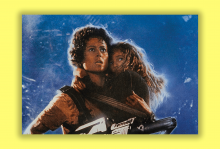
WHEN AUTHOR AND film critic Sarah Welch-Larson was growing up, she wasn’t a horror movie fan. That started to change when, as a teenager, she had a fateful encounter with the James Cameron film Aliens on cable TV.
The movie’s hero, Ellen Ripley, played by Sigourney Weaver, “looked a lot like my mom and had a lot of the attitudes my mom has about some things,” Welch-Larson, who writes about faith and popular culture for the online publications Think Christian and Bright Wall/Dark Room, told Sojourners. “I was captivated by that character.” Two weeks later, Welch-Larson watched the first 1979 Alien movie, directed by Ridley Scott. It frightened her and she couldn’t get it out of her head.
Eventually Welch-Larson’s interest grew into a fascination with the series as a whole. Her new book, Becoming Alien: The Beginning and End of Evil in Science Fiction’s Most Idiosyncratic Film Franchise, looks at recurring themes of evil, greed, and destruction in the Alien films through the lens of theologian Catherine Keller’s 2002 book, The Face of the Deep: A Theology of Becoming, in which Keller examines the first two verses of Genesis.
“She writes a lot about God setting everything into relationship with each other. God’s saying there’s a relationship you have with the rest of the world and with other created beings around you,” Welch-Larson explains. “Once you start to deny those relationships, you’re saying they’re not as important as what God has created you to be, and Keller says that’s the source of evil.”
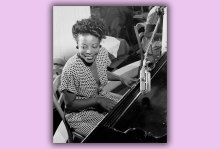
FROM THE 1920s until her death in 1981, Black jazz pianist and composer Mary Lou Williams injected energy and innovation into the genre and, via three jazz Masses composed after her conversion to Catholicism in the 1950s, into the church. Still, her music is sometimes overlooked, while the popularity of male jazz musicians’ work—including her mentees Thelonious Monk and Charlie Parker—persists.
In this century, Deanna Witkowski is amplifying Williams’ works of music and faith. Witkowski is a jazz pianist herself, inspired by Williams, and a doctoral student in the jazz studies program at the University of Pittsburgh. She is restoring and recording general and liturgical compositions by Williams, some of which haven’t been recorded since 1944. And she has written a biography of the pioneer, Mary Lou Williams: Music for the Soul (Liturgical Press). Witkowski spoke with Sojourners associate editor Da’Shawn Mosley about the book and its namesake.
Da’Shawn Mosley: How did you become interested enough in Mary Lou Williams to write a biography of her?
Deanna Witkowski: In 2000, Dr. Billy Taylor, a jazz musician himself and the judge from a jazz piano competition I had played the year before, contacted me and said, “Come bring your quintet to play at the Mary Lou Williams Women in Jazz Festival at the Kennedy Center in the spring.” And so of course I said, “Yes, I would love to do this.” And then thought, “I really don’t know Mary Lou Williams’ music.” That’s a very common thing, even among jazz musicians or aficionados. She has this reputation [as] this great pianist and composer who wrote big-band music for Duke Ellington and Benny Goodman and mentored all these famous jazz musicians—so we know Thelonious Monk. But her compositions aren’t very well known.